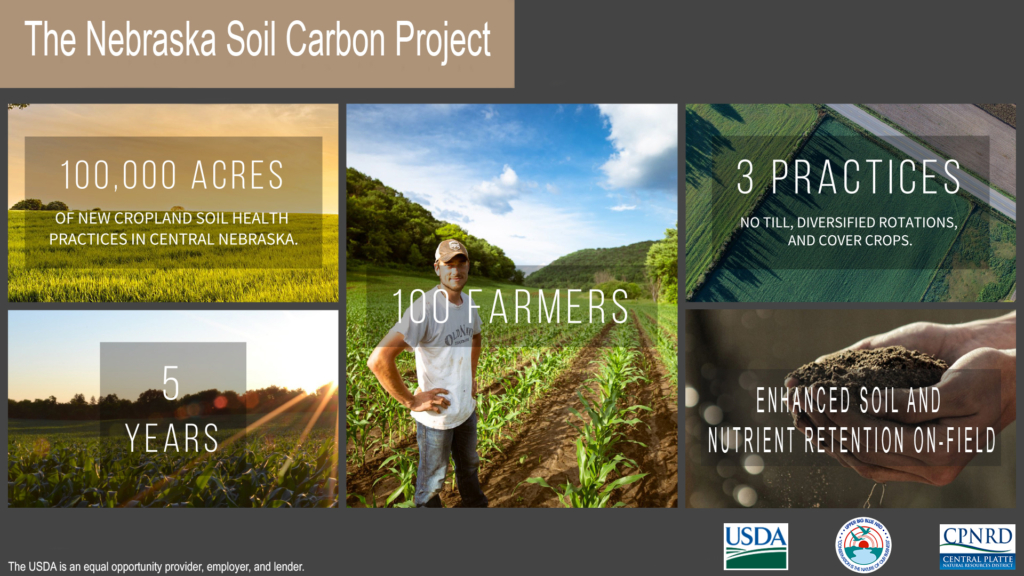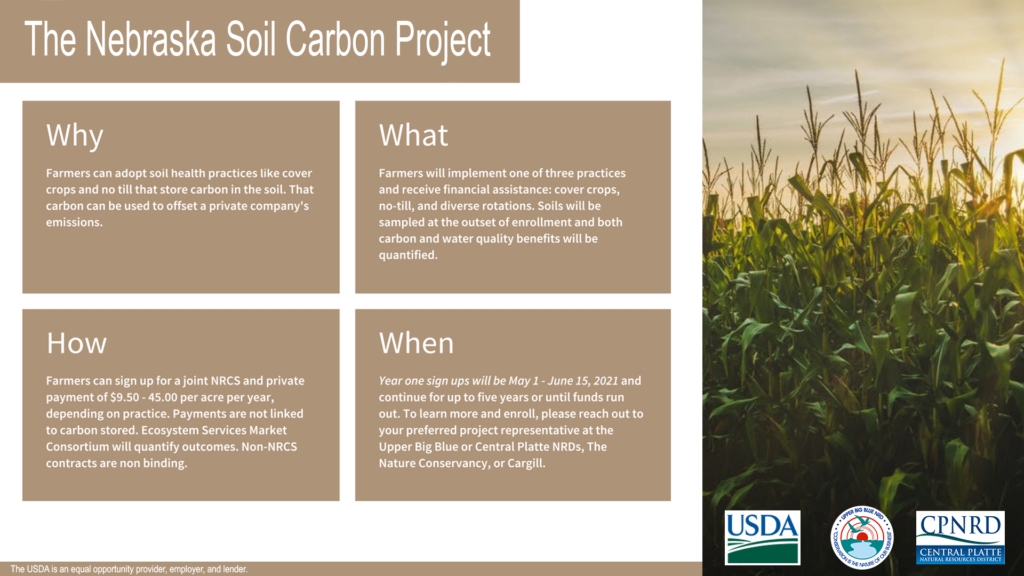Land Management
Cropland, forestland, pastureland, and rangeland comprise the major land uses in the Central Platte NRD. The land uses receiving the majority of the conservation treatment address our soil, water, agricultural resources.
The Central Platte NRD, Natural Resources Conservation Service (NRCS), and Farm Service Agency provide cost-share funding and/or technical assistance for land management practices. Major land use natural resource concerns include:
(1) erosion by wind and water
(2) maintaining and enhancing soil quality
(3) water quality and quantity
(4) plant condition and health
(5) wildlife habitat

 Sign Up for Soil Carbon Credit Project
Sign Up for Soil Carbon Credit Project
- Farmer Resource: Recruitment and Enrollment Basic Information (PDF)
Funding Available for Soil Carbon Conservation Practices in Central Nebraska
November 17th is the deadline for producers in the Central Platte and Upper Big Blue Natural Resources Districts (NRDs) to apply for the current round of funding through the Nebraska Soil Carbon Project. This project provides financial incentives to producers who utilize key conservation practices in central Nebraska. Farmers can adopt soil health practices--including cover crops, no-till, and diverse crop rotations--that store carbon in the soil. Private companies hope to utilize the stored carbon and water quality benefits to help reach their goals around sustainability.
The goal is to have about 100 producers installing these soil health practices on 100,000 acres over the duration of the five-year project. With three enrollment periods completed, 59 farmers have committed over 70,325 treated acres to implement conservation practices between 2021 and 2028. Applications must be submitted by Friday, November 17, 2023, to be evaluated for the next round of funding.
The Nebraska Soil Carbon Project is a collaboration between the two NRDs, Natural Resources Conservation Service (NRCS), The Nature Conservancy, Ecosystem Services Market Consortium, Cargill, Target, and McDonald’s. The Nature Conservancy manages this program that is investing $8 million for farmers to implement these practices over the next few years.
Increasing cropland soil carbon has multiple benefits for the producer and the environment, including more stable yields, improved nutrient availability and water holding capacity, and climate stabilization. Private companies are looking for ways to decrease their carbon footprint partnering with Nebraska’s growers can provide these benefits by improving farming operations and implementing soil health practices. Markets linking these soil carbon buyers and suppliers allow companies to meet part of their greenhouse gas reduction goals while supporting farmers in implementing new conservation practices.
The payments producers receive through this soil carbon pilot project are tied to the practices implemented on the acres, not the carbon outcomes, to reduce producers’ risk. The goal of this pilot project is to provide participating farmers with the opportunity to evaluate the potential to leverage these programs on their operation. Beyond the financial incentives and soil health benefits, participating producers will have the opportunity to:
- Share conservation stories with a larger audience via field days, media spots, and short videos relating to the project.
- Attend training events with local and national leaders in soil health, agronomy, and related topics.
- Receive a report on the new practice’s soil carbon and water quality outcomes. Those interested in going deeper may also opt in for a detailed report on the practice’s financial return on investment.
Producers receive year-round assistance from the NRDs, NRCS, and The Nature Conservancy staff, who provide support for paperwork/application processes and soil health practice management. There is no gross income or acre enrollment cap for NRCS payments. Still, producers are encouraged to enroll a reasonable number of acres given their operation size and soil health experience. More acres can be submitted for enrollment in subsequent years of the program. Payments are for new soil health acres only. However, a measurable improvement of an existing practice could count (such as moving from strip-till to no-till or switching from a single-species cover crop to multi-species) if it aligns with the NRCS’s standards.
Interested in adding conservation practices to your acres?
Central Platte NRD: Visit https://www.cpnrd.org/land management/soil health to get started today, or contact Courtney Widup at (308) 385-6282 or widup@cpnrd.org.
Upper Big Blue NRD: Visit www.upperbigblue.org/soilcarbonproject to get started today or contact Marie Krausnick at (402) 362-6601 or mebel@upperbigblue.org.
USDA is an equal opportunity provider, employer and lender.
 Why
Why
Farmers can adopt soil health practices like cover crops, no till, and diverse crop rotations that store carbon in the soil. That carbon can then be used to offset a private company's emissions.
What
Farmers will implement one of three practices and receive financial assistance: cover crops, no-till, and diverse rotations. Soils will be sampled at the outset of enrollment and both carbon and water quality benefits will be quantified.
When
Year one sign ups will be May 1 - June 15, 2021 and continue for up to five years or until funds run out. To learn more and enroll, please reach out to your preferred project representative at the Upper Big Blue or Central Platte NRDs, The Nature Conservancy, or Cargill.
How
Farmers can sign up for a joint NRCS and private payment of $9.50 - 45.00 per acre per year, depending on practice. Payments are not linked to carbon stored. Ecosystem Services Market Consortium will quantify outcomes. Non-NRCS contracts are non binding.
 PAYMENTS
PAYMENTS
$9.50 - 45.00/acre annually of financial assistance. Payment depends on type of soil health practice and enrollment in the ESMC pilot. Practices can include reduced tillage, diverse rotations, and cover crops, according to NRCS practice codes.
Payments to producers will be paid by acres of practice adopted, instead of being linked to carbon storage. Ecosystem Services Market Consortium (ESMC) will quantify carbon and water quality outcomes.
There is no gross income or acre enrollment cap for NRCS payments, but producers are encouraged to enroll a reasonable number of acres given their operation size and soil health experience. More acres can always be submitted for enrollment in following years
A producer can choose to enroll in just the NRCS component or just the ESMC component if they choose. However, to receive the full payments and benefits of the project, we encourage them to enroll in both aspects of the project if they are able.
REPORTS
Each producer will receive a report on the new practice's soil carbon and water quality outcomes. If they opt in to providing additional economic data, producers can also receive a detailed report on the practice's financial return on investment (ROI).
TRAINING
Year round assistance from NRD, NRCS, and TNC staff to support paperwork/application process and soil health practice management. Opportunity to attend training events, post-COVID, with local and national leaders in soil health, agronomy, and other relevant topics. Meals will be included.
SHARING
Share conservation stories with a larger audience. Producers can take part in or lead field days, media spots, short project videos, etc.
 All farmers and landowners are encouraged to seek out the ecosystem and carbon payments platform that works best for their situation. ESMC is a collaborator on this project because they offer a low-risk way for farmers to explore carbon market payments for new soil health practices. Specifically:
All farmers and landowners are encouraged to seek out the ecosystem and carbon payments platform that works best for their situation. ESMC is a collaborator on this project because they offer a low-risk way for farmers to explore carbon market payments for new soil health practices. Specifically:
Contract is Non-Binding
Farmers will sign annual contracts. If they choose to not renew their contracts, they can leave the program without penalty from ESMC to enable farmers to try it without a binding, multi-year contract.
Payments are Non-Variable
Many other carbon payments are variable year to year and based on actual carbon storage rates. This pilot will pay farmers a flat rate of $3/acre per year regardless of current market payment rates or the amount of carbon stored per year to give farmers certainty around the level of revenue they'll generate through this project.
Simplified Data Collection
ESMC is piloting multiple data collection methods, including remote imaging, to reduce the data burden placed on farmers. All farms enrolled in the ESMC Pilot will be sampled at the outset of the project and again in year 5, should the producer remain enrolled for the entire 5 years of the project.
ESMC is Non-Profit
ESMC's non-profit structure minimizes transaction costs and maximizes value for farmers. They are a private-public partnership,
with backing from Foundation for Food and Agriculture Research.
 Our project is committed to ensuring that farmers are the primary beneficiaries of any value derived from their data.
Our project is committed to ensuring that farmers are the primary beneficiaries of any value derived from their data.
Privacy
Farmers own their raw data and control the fate of their data including who sees it, how it's used, and where and how long it's stored. Rights to their carbon are only transferred when they sign up with ESMC and complete data entry. Data will be stored by ESMC on a secure server for the duration of the producer's enrollment plus three additional years. The only entities automatically able to view farmer names, locations, and project data are TNC and ESMC. Other project coordinators will not have access to raw farmer data without the express consent from the farmer. The only publicly shared data will be around whole-project outcomes, i.e., no publicly available information can be linked to any one farmer or location.
Transparency
Farmers can choose to share their data with other project partners. Additional project partners could include The Central Platte and Upper Big Blue NRDs, The Nature Conservancy, and/or Colorado State University. Farmers will not be penalized in any way by not opting in to sharing their data with additional project partners.
Simplicity
We are committed to collecting only the data needed to meet project outcomes - no more, and no less.
 A producer retains their rights to project carbon until they sign the Producer Agreement with ESMC and receive the $3/acre payment, at which point ESMC will transfer rights to the producer's carbon to project buyers (McDonalds, Target, and Cargill). We estimate that the project will generate 150,000 metric tons of carbon dioxide equivalent (C02-e), but the final tally will depend on calculations done by ESMC based on soil sampling and model estimates.
A producer retains their rights to project carbon until they sign the Producer Agreement with ESMC and receive the $3/acre payment, at which point ESMC will transfer rights to the producer's carbon to project buyers (McDonalds, Target, and Cargill). We estimate that the project will generate 150,000 metric tons of carbon dioxide equivalent (C02-e), but the final tally will depend on calculations done by ESMC based on soil sampling and model estimates.
In this project, any resulting carbon was "prepaid" for by the funding companies. Farmers will be paid for acres of practices adopted and not based on rate of carbon storage. This means that the companies have already taken a risk that the project's enrolled acres may not generate the entire 150,000 metric tons of C02-e they paid for. This was done to shift the risk of under-storing carbon to the companies and not to the farmers.
 One major difference between this project and others is that payments will be tied to the total acres of soil health practices and not soil carbon sequestered. We did this because we want farmers to know the costs and benefits of the project at the outset. Carbon storage, and the associated payments, could be highly variable.
One major difference between this project and others is that payments will be tied to the total acres of soil health practices and not soil carbon sequestered. We did this because we want farmers to know the costs and benefits of the project at the outset. Carbon storage, and the associated payments, could be highly variable.
While this pilot will pay farmers $3/acre up front for their potential carbon, the eventual ESMC marketplace will compensate farmers for the actual quantity of carbon stored, one year post-quantification.
As the science improves, it will be less risky to link payments to carbon. But for now, we did not want producers to take on the risk of unknown payments by signing up for this project. Another difference between this project and others is that we have no acreage minimums for enrollment.
Finally, farmers will retain ownership over their raw data.
If a producer falls behind on the contract schedule and the reason is not within their control (beyond normal farming risks), NRCS will do a rescheduling modification, i.e., extend out the contract a year or two. If the reason is within their control, NRCS will allow one rescheduling modification with a notice of contract violation using form CPA-153, giving the producer up to 12 months to correct the violation. If the producer has not completed a practice within the specified time frame on the CPA-153, NRCS would reassess the situation. Continued violation may result in contract termination.
If a farmer exits their NRCS contract before the expiration date with incomplete items and the reason is in good faith or for circumstances that occurred not within the producer's control (death, repeated weather events, etc) and NRCS/Partners are in agreement, we can cancel the contract and with no penalty.
Similarly, a producer will not be eligible for the $3/acre annual payment in years they are unable to implement the practice, but they will have the option of extending their enrollment to make up for that payment at the end of the project. Producers are, however, still encouraged to access other project features during years that they are unable to implement the practice(s). Those benefits include lunch events, opportunities to speak with the press, and technical assistance.
Soil Quality
Soil health also referred to as soil quality, is defined as the continued capacity of the soil to function as a vital living ecosystem that sustains plants, animals, and humans. This definition speaks to the importance of managing soils so they are sustainable for future generations. To do this, we need to remember that soil contains living organisms that when provided the basic necessities of life – food, shelter, and water – perform functions required to produce food and fiber.
Soil is an ecosystem that can be managed to provide nutrients for plant growth, absorb and hold rainwater for use during drier periods, filter and buffer potential pollutants from leaving our fields, serve as a firm foundation for agricultural activities, and provide habitat for soil microbes to flourish and diversify to keep the ecosystem running smoothly. Learn more about how Soil Biology plays a major role in soil health.
Healthy soil gives us clean air and water, bountiful crops and forests, productive grazing lands, diverse wildlife, and beautiful landscapes. Soil does all this by performing five essential functions:
- Regulating Water
- Soil helps control where rain, snowmelt, and irrigation water goes. Water and dissolved solutes flow over the land or into and through the soil.
- Sustaining Plant and Animal Life
- The diversity and productivity of living things depend on soil.
- Filtering/Buffering Potential Pollutants
- The minerals and microbes in the soil are responsible for filtering, buffering, degrading, immobilizing, and detoxifying organic and inorganic materials, including industrial and municipal by-products and atmospheric deposits.
- Cycling Nutrients
- Carbon, nitrogen, phosphorus, and many other nutrients are stored, transformed, and cycled in the soil.
- Physical Stability & Support
- Soil structure provides a medium for plant roots. Soils also provide support for human structures and protection for archeological treasures.
___________________________________________________________
🦠 Key ways in which Soil Microbes affect Soil Health
📉 Disease Risk: Soil microbes can help to reduce the risk of diseases in plants by competing with pathogenic microbes for nutrients and space.
💪 Stress Adaptation: Soil microbes can help plants to adapt to environmental stresses, such as extreme temperatures or drought.
For example, certain bacteria and fungi can produce compounds that help plants to tolerate drought conditions, while others can help plants to tolerate extreme temperatures.
🌱 Nutrient Cycling: Soil microbes play a crucial role in the cycling of nutrients in the soil. They decompose organic matter, releasing nutrients that plants can absorb. They also help to convert inorganic nutrients, such as nitrogen and phosphorous, into forms that plants can use.
💡 Hormone Production: Some soil microbes produce hormones or other growth-promoting compounds that can help plants to grow and develop.
For example, certain bacteria produce auxins, which are hormones that stimulate root growth and help plants to absorb nutrients.
🍃 Biocontrol: Soil microbes can also play a role in controlling pests and diseases.
For example, some bacteria and fungi produce compounds that can inhibit the growth of pest insects or fungi, while others can stimulate the growth of predatory insects or fungi that feed on pests.
Rolling hills and shallow drainages are common in central Nebraska. Along with the beautiful rolling hills of Nebraska farmland, come some not so beautiful problems: runoff and soil erosion. The runoff water that goes through gullies and into streams or ditches can carry excess pollutants and sediment into streams and rivers. This impacts the quality and quantity of water in our area. Buffer strips are a valuable tool to reduce runoff and erosion. A Buffer strip is a strip of native vegetation that has been planted and established along drainages.
These strips offer many real advantages including:
- Increased water quality through filtration.
- Increased water quantity through slowed and captured runoff, and snowmelt.
- Enhanced wildlife habitat.
- Decreased erosion, and fieldwork.
By planting native tall grasses in low areas next to streams and drainages, runoff is slowed and water is captured and cleaned. And since these areas are often challenging to farm, and lower in productivity, farmers can save time and expense with buffer strips as well.
CPNRD BUFFER STRIP PROGRAM
Funding for the Buffer Strip Program is from a fee assessed on pesticides registered for sale in Nebraska and is administered by the Nebraska Department of Agriculture, Nebraska’s natural resources districts, and the USDA Natural Resources Conservation Service. Contracts are 5 to 10 years in length.
Dryland Payment Rates
- Dryland cropland enrolled in CRP, CREP, or other governmentally-funded programs, payment rate per acre is 20% of the weighted average soil rental rate.
- Dryland cropland not enrolled in CRP, CREP, or other governmentally-funded programs, payment rate per acre is equal 120% of the CRP weighted average soil rental rate plus $5, minus payments from any other source. (CRP weighted average soil rental rate is the amount calculated before the incentive and maintenance rate are added.) In no case may the payment from all sources exceed $250 per acre.
Irrigated Cropland Payment Rates
- For irrigated cropland enrolled in CRP, CREP, and/or any other governmentally-funded program, the payment rate per acre is $250, minus payments received from all other sources.
- For irrigated cropland not enrolled in CRP, CREP, and/or any other governmentally-funded program, the payment per acre is $225, minus any other program payments.
Kelly Cole
cole@cpnrd.org
308-385-6282
From a soil perspective, the benefits of no-till farming far outnumber those of tillage-based systems. No-till practices allow the soil structure to stay intact and also protect the soil by leaving crop residue on the soil surface. Improved soil structure and soil cover increase the soil’s ability to absorb and infiltrate water, which in turn reduces soil erosion and runoff and prevents pollution from entering nearby water sources.
No-till practices also slow evaporation, which not only means better absorption of rainwater, but it also increases irrigation efficiency, ultimately leading to higher yields, especially during hot and dry weather.
Soil microorganisms, fungi and bacteria, critical to soil health, also benefit from no-till practices. When soil is left undisturbed, beneficial soil organisms can establish their communities and feed off of the soil’s organic matter. A healthy soil biome is important for nutrient cycling and suppressing plant diseases. As soil organic matter improves, so does the soil’s internal structure—increasing the soil’s capacity to grow more nutrient-dense crops.
Tilling became popular because it meant farmers could plant more seeds; however, modern no-till tractor implements allow farmers to sow seeds faster and cheaper than if they tilled their fields. Conventional tillage practices require the farmer to make several passes over the field, first tilling the soil and then returning to plant seeds. No-till removes the step of tilling the soil and therefore saves the farmer time and money. According to a report published in Scientific America, this decreases the fuel expense by 50-80% and the labor by 30-50%.
Cover Crop Impact Study:
The effect of cover crops on potential groundwater recharge and nitrate movement through the soil profile
The planting of cover crops is utilized for many soil health benefits, and it is widely accepted that cover crops reduce erosion by anchoring the soil. One thing not often discussed is how cover crops might affect potential groundwater recharge and if there is the possibility of negative impacts to water quantity and to the producer’s water budget. To explore these possibilities further, the Lower Loup NRD and the Central Platte NRD partnered with EA Engineering, Science, and Technology, Inc, PBC to study the impacts of growing cover crops in southern Buffalo County where the aquifer is limited, and the water levels have declined in recent years. The study area is between the Wood River and South Loup River.
Within this area, three irrigated row crop fields were selected and monitored for a period of three growing seasons.
The project aimed to gain a better understanding of the general influence of cover crops on soil moisture and potential groundwater recharge. Soil samples to a depth of 15 foot were also collected to study the movement of nitrate vertically through and below the root zone.
The study design was to select fields where during winter months, the grower would plant half the field with a cover crop and maintain the other half with no cover crop. This would allow for a comparison between Cover Crop and No Cover Crop in the same field.
Soil moisture probes were installed at depths of 18, 72, and 84 inches to monitor the movement of water through the root zone and into the unsaturated zone, also known as the vadose zone. Water not utilized by the growing crop would be accounted for by the deeper sensors and would be considered groundwater recharge. A cellular gateway allowed for the collection of data throughout the entire calendar year. Equipment was only removed for the planting and harvesting of crops.
At the completion of the project, the annual potential groundwater recharge was averaged together across the three fields for the entire study duration. Results showed no statistical difference between Cover Crop and No Cover Crop areas.
Since individual seasons or years can vary greatly, longer duration data may be needed to determine if a consistent trend is observed and allow for developing long-term conclusions.
For additional information, please contact Jason Moudry at the Lower Loup NRD at (308) 728-3221.

-
Main Office
- 215 Kaufman Ave, Grand Island, NE 68803 308-385-6282
-
Cozad Office
- 75887 Road 414, Cozad, NE 69130 308-380-8943
-
NRCS Field Offices (Ext. 3)
- Central City 308-946-3035
- Kearney 308-237-3118
- Grand Island 308-395-8586
- Lexington 308-324-6314
- Osceola 402-747-2461




